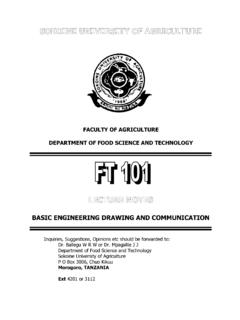Transcription of A START IN PUNJABI
1 A START IN PUNJABI (Based on comparative structures of PUNJABI and American English) HENRY A. GLEASON, JR. HARJEET SINGH GILL 2013 edition, revised by MUKHTIAR SINGH GILL PUNJABI UNIVERSITY, PATIALA A START IN PUNJABI by Henry A. Gleason, jr. Harjeet Singh Gill 2013 edition, revised by MUKHTIAR SINGH GILL The Advanced Centre for the Technical Development of PUNJABI Language, Literature and Culture. PUNJABI University Patiala. PREFACE A START IN PUNJABI is based on detailed analyses of sound patterns and syntactic structures of PUNJABI and American English. It may be used alongwith its companion volume, A REFERENCE GRAMMAR OF PUNJABI , where the authors have dwelt upon colloquial as well as cultivated expressions collated from contemporary literature.
2 There is also a chapter on the Gurumukhi writing system. This book was first circulated in the United States in mimeograph form in Hartford Studies in Linguistics, 1963. Harjeet Singh Gill PUNJABI University, Patiala, 1970. The 2013 edition is annotated and revised by Mukhtiar Singh Gill, Project Associate, with the active participation of Professor Gurpreet Singh Lehal, Director of the Advanced Centre for the Technical Development of PUNJABI Language, Literature and Culture, PUNJABI University, Patiala. Harjeet Singh Gill Professor of Eminence PUNJABI University, Patiala, 2013. CONTENTS Lesson one : Introduction unaspirated ..1 consonants high tone. Lesson two : Welcome Home vowels..10 Lesson three : Welcome Home consonants.
3 17 (k c t p / g j d b), r. Lesson four : Dining consonants ..23 (k c t p / kh ch th ph), PUNJABI and English v/w. Lesson five : Fruit Market single and ..32 double consonants, PUNJABI and English a/ , present/ future. Lesson six : Sweets shop retroflex ..38 sounds, PUNJABI and English r/ / , feminine/ masculine, counting. Lesson seven : Market tones, counting..45 Lesson eight : Directions, hiring ..50 a rickshaw- / / / , tones, infinitive, present, future, counting in fractions.
4 Lesson nine : Fruit Market-retroflex ..58 lateral, / , singular/plural, feminine/ masculine, positive/ negative. Lesson ten : Golden Temple Amritsar tones, ..63 narrative, present continuous. Lesson eleven : A Folk-Tale (of a crow and ..69 sparrow) - summary of consonants and vowels, ph/f, j/z, nasals, tones on different syllables, narrative past tense. Lesson twelve : A Legend (Guru Nanak and ..77 Mardana) - narrative, different forms of past tense, instrumental constructions, case forms.
5 Lesson thirteen : Diwali (the festival of ..83 lights) the sentence structure, narrative present tense, forms of the auxiliary. Lesson fourteen : Id (an important Muslim ..88 festival) narrative present tense, verb phrases. Lesson fifteen : Lohri (the winter festival of ..97 fire) future tense, past tense. Lesson sixteen : Agriculture use of what, .. 105 where, who, why, emphatic, negative, other forms of questions. Lesson seventeen : On the Farm general ..112 dialogue, imperatives, pronouns.
6 Lesson eighteen : Around the kitchen in ..119 village present, past, future commands, requests, suggestions, subordinate clauses. Lesson nineteen : Vegetable Market emphatics, ..129 intonation. Lesson twenty : Suggestions for further study..138 1 LESSON ONE DIALOGUES Dialogues in Gurmukhi ? , ? , , , , ?
7 , ? 2 Transcription of above Dialogues m s g sat sir ak l. s s g sat sir ak l. m s g k h l e? s s g a h , tus su o. m s g m rb n . r m l l namaste. mot namaste. r m l l p oge? mot na , ko takl f n karo. r m l l na , ko takl f na . mot a h , m rb n . d n sal m. beg sal m. o, dar o. kiw e? d n ew , mil w ste. beg p oge ? d n a h . Translation of above Dialogues Mohan Singh /sat sir ak Sohan Singh /sat sir ak Mohan Singh How are you ?
8 Sohan Singh Fine. How about you? Mohan Singh Fine, thank you 3 Ram Lal Moti Ram Lal Will you have some tea? Moti No thanks. Don t bother. Ram Lal It s no trouble. Moti , thanks. Din /sal Beg /sal Come in. What brings you here? Din Just to see you. Beg Have some tea? Din All right. USAGE NOTES /sat sir ak is the usual greeting between Sikhs. is usual greeting between Hindus. /sal m. / is a usual and informal greeting between Muslims or Christians. If you are observant, you will soon learn which is appropriate under any set of circumstances.
9 The remainder of each of the three opening dialogues above can be used with any of the three opening formulas. For example, you might START with /namaste/ and continue with /k h l e?/. After practicing the dialogues just as they are given try making these re-combinations. Dialogue is a typical brief interchange as two people meet. It can be used in almost any place or in almost any situation. and are typical greetings as one person comes to visit another in his home. might be used even if the visitor comes for some serious business. Etiquette demands that the business should not be brought up until after some exchange of pleasantries. All of these, of course, are short. Frequently longer interchanges will be used. 4 Your instructor will demonstrate for you the gestures which commonly accompany these greetings. They are part of the total dialogue, and should be practiced alongwith the words.
10 The gestures in use in Punjab differ in many ways from those in use in America. It is very nearly as important to learn to use and understand the gestures as it is to learn the vocal language. Make a habit of watching your instructor as he speaks and imitate him. If you do not hear or understand something, you may say ? tus k ki ? or for short, just : ? k ki ? or even: ? k ? In such a situation, all of these would mean something like What did you say ? The longer form is, of course, more formal. PRONUNCIATION The PUNJABI sound we transcribe as /t/ is quite different from the English t . This difference can be easily heard by comparing some PUNJABI words with some roughly similar English words.





